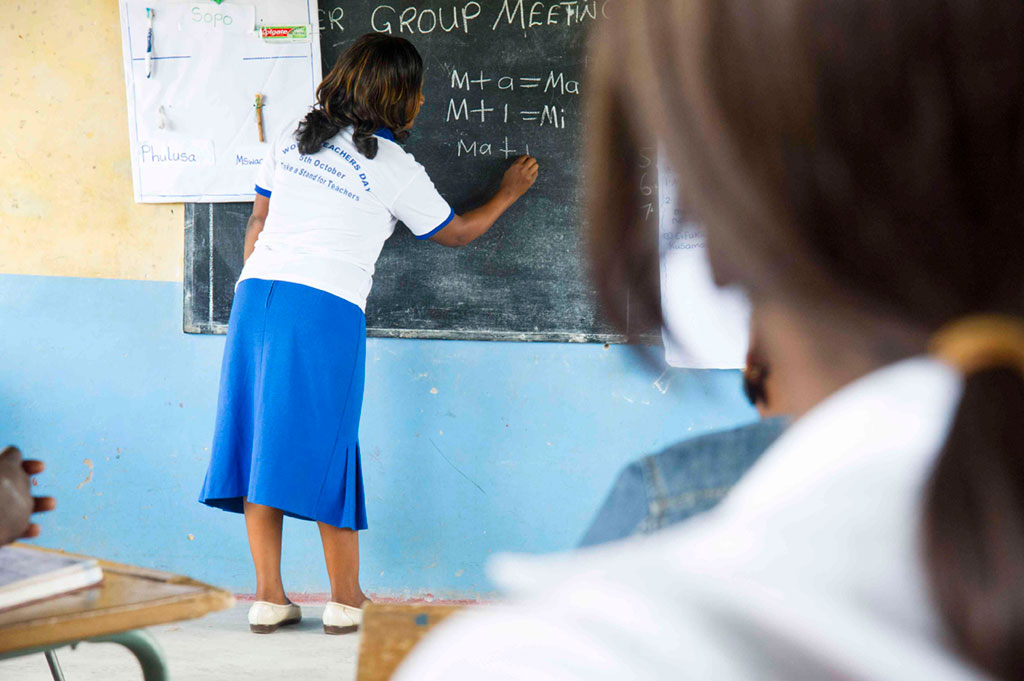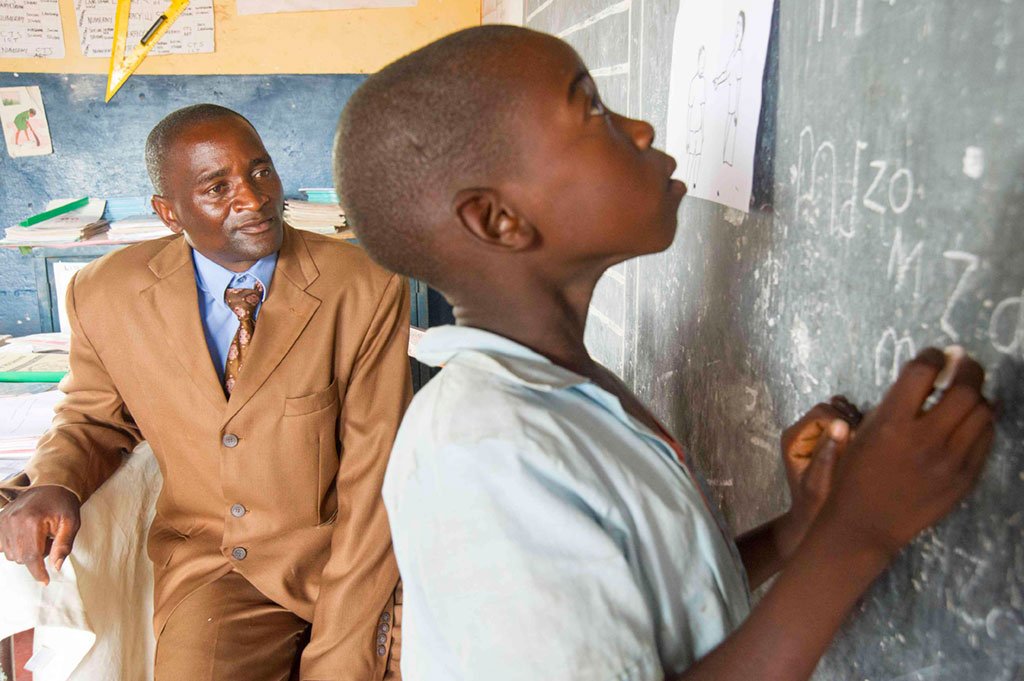Chipata, Zambia—Inside the classroom, with their students on recess outside, seven primary school teachers scramble to assemble a word puzzle, moving around paper letter tiles in a race to spell the assigned word.
In this classroom, it is the teachers who are learning as they practice new active, phonics-based methods that will improve their learners’ literacy levels.
The Gondar Primary School, where they teach, is one of more than 1,200 schools around Zambia taking part in Read to Succeed—a U.S. Agency for International Development-funded project to improve reading among pupils in grades 1 to 4 in local Zambian languages.
Continuing professional development, including teacher group meetings, is a key component of the project’s “whole school, whole teacher, whole learner” approach.
“We work with teachers individually to develop their skills in reading pedagogy and to become professional, reflective practitioners, to be motivated and responsive to their children and be accountable for the results of their students,” says Tassew Zewdie, Chief of Party for USAID/Read to Succeed, which is implemented by Creative Associates International.
Only around 65 percent of Zambians ages 15 to 24 are literate, according to UNESCO data from 2015, placing the country well behind its neighbors in the Southern African Development Community. Poor teaching methods and ineffective curriculum have been part of the problem, according to education officials, and pupils were taught in English before they could read or write in their mother-tongue.
“At all levels, from foundation level up to tertiary education, the reading culture has been very low in Zambia,” says Francis Sampa, Deputy Chief of Party and Teacher Development Advisor for USAID/Read to Succeed. “The challenges include have a lack of reading resources in schools and inadequate training among the teachers for teaching reading.”
Guided by the Ministry of Education, Science, Vocational Training and Early Education’s (MESVTEE) Primary Literacy Familiar language curriculum, USAID/Read to Succeed has trained more than 6,200 teachers and more than 3,100 education managers in the effective phonics-based reading pedagogy.
“The teachers have to be capacity-built, they have to be trained in order for them to implement [the new curriculum] effectively,” says Esvah Chizambe, Assistant Director of Teacher Education at the MESVTEE.
Phonics, key to teaching literacy

Phonics is one of the five major components of reading instruction, in which teachers are trained, along with phonemic awareness, fluency, vocabulary and comprehension.
At Katopola Primary School in Chipata, Head Teacher Edna Simwanza says the phonics-based teaching tools are revolutionizing student learning.
“Before Read to Succeed, a child could go to grade four without knowing how to read. They could identify maybe pictures, but relating the picture to words was a problem,” she says. “But after Read to Succeed came, we have seen the methodology changing where children are taught how to sound the letters, and not to name the letters…. It has helped them to attack the words in a better way.”
In Katopala Primary School classrooms and around Zambia’s Eastern Province, there are loud and clear signs that the phonics-based teaching methods are helping learners read.
In Tembo Aaron Mangani’s third grade class at the Mankhaka Primary School in rural Lundazi, pupils shout at answers as they sound out words beginning with the sound of the day— “nkh.”
As Mangani posts a short story he has written on the board, featuring the sound “nkh”—a method he learned in training—students’ hands shoot into the air, hoping for a chance to put their new skills on display. He says that in the past, his pupils had difficulty reading and used to rely on pictures to memorize the words of a story.
“If you remove the picture, then the reading goes,” he says. “But now they are able to attack a word using the sounds. That has greatly improved the reading levels.”
Coaching and collaboration sparks creativity

Through the MESVTEE’s Education Support Teams at the national, provincial, district, zonal and school level, USAID/Read to Succeed ensures that ongoing support and professional development is available to teachers and head teachers as they practice these new approaches.
“By using education support teams that are based at these various, we would like to bring the training as close as possible to the teachers,” says Sampa.
The in-service training teams are especially critical, says Chizambe, MESVTEE Assistant Director for Teacher Education.
“My officers in the in-service unit—the reading team—are ensuring that the teachers are receiving the capacities they needed to implement the literacy program,” she says.
The MESVTEE and USAID/Read to Succeed have also mainstreamed the Primary Literacy Program in the pre-service teacher education program to train in-coming primary teachers at colleges of education in the revised curriculum, says Chizambe.
At each participating primary school, between four to six teachers have been trained in improved methods for teaching literacy, so that they can serve as mentors to their fellow teachers, using the USAID/Read to Succeed Teacher’s Guide and School-Based Coaching Handbook.
“In the training manuals, we have encouraged teachers to meet after zone trainings in their schools to share what they learned with other teachers who may not have attended so that they can work together and identify the good practices that they can encourage in their school,” says Sampa.
Head teachers for their part have received special education leadership and management training to conduct group learner assessments, carry out classroom observations and provide feedback to teachers, pupils and parents for remedial actions.
“We also build the capacity of head teachers particularly looking at head teachers not as administrators but as instructional leaders. So we provide them with necessary skills in order to provide professional support to their teachers in their schools…. or guidance and counseling to students and parents and teachers,” says Zewdie.
Judith Mwendaendi, Head Teacher at Kanele Primary School in Lundazi, says that the peer coaching she has provided to her primary literacy teachers has been very beneficial, energizing her staff and sparking new ideas for teaching.
“My teachers, they are interested in learning how to teach literacy using the methodology. And the main thing that is brought out is creativity. They are saying it is making them think and do a lot,” she says.
Whether introducing new reading games or writing original stories using phonics and local themes, teachers collaborate regularly to sharpen their instructional skills. Much of this coaching and educator collaboration takes place in regular teacher group meetings.
“In the teacher group meetings, we talk about the lesson studies, where we discuss the challenges that we are facing in classes,” says Elizabeth Zimba, a first grade teacher and the in-service training coordinator at Kanele Primary School. “We share a lot of ideas in the teacher group meetings. Sometimes we learn even what we didn’t know.”
Coaching goes mobile
With more than 1,200 primary schools participating in the USAID/Read to Succeed Project across six provinces, often in remote rural areas, keeping tabs on teacher and student performance can be challenging for the MESVTEE.
However, USAID/Read to Succeed has developed an innovative SMS mobile reporting and coaching system, called Zambia Schools Gateway, which has made tracking teacher and student progress and connecting educators nationwide as easy as a hitting the “send” button.
The project has trained all head teachers as well as all district resource center coordinators, district standard officers, district statisticians and provincial standard officers on the use of system. The cellphone-based reporting application allows head teachers to enter data on their students’ and teachers’ performance into a database that can be viewed at the district level.
“Those reports are then turned into report cards, which go back to the schools in zones, and that’s the basis for everyone to see areas of strengths and weakness, so that they can identify the problem and come up with strategies to fix them,” says Guy Bostock, who manages the Zambia Schools Gateway and oversees head teachers’ training and coaching for USAID/Read to Succeed.
Through the SMS system, MESVTEE district officials can send questions to all head teachers in a particular zone, he explains.
“So they might ask, “What problems are you having with implementing the primary literacy program in grade three?” And then every head teacher can send back his own answer.”
Bostock says teachers may say cite a lag in training of a new teacher, a lack of materials or issues pronouncing certain phonetic sounds. The District Education Support Team then views these responses and determines where extra support is needed to teachers.
New tools at the right time
Equipped with the revised literacy curriculum and supported by fellow teachers in their schools, teachers in primary schools and school leaders are finding new enthusiasm and promise in their efforts to teach reading and writing.
“Head teachers and deputy heads do seem to be much more excited about their work,” says Bostock. “I think some of the tools we’ve given them, like classroom observation schedule to use to watch teachers teaching early grade reading and give them coaching, and also a sampling test that the head teachers administer to the grade two [students] twice a year, that’s really given them tools to see what’s happening.”
And “what’s happening” in the classrooms across Eastern Province is substantive literacy gains among primary school pupils and renewed commitment among teachers to use their phonics-based teaching skills to bring literacy to life.
“Many teachers and learners in schools have started working very hard,” says Head Teacher Mwendaendi.
She says the USAID/Read to Succeed project came at the right time when teachers in the district were struggling to teach reading effectively and students were performing poorly.
“So when Read to Succeed came, as managers or administrators, we saw that it was a blessing in disguise,” she says. “Because looking at the way the procedures are being taken, most of the teachers are enjoying their teaching, and the learners have achieved a lot.”
